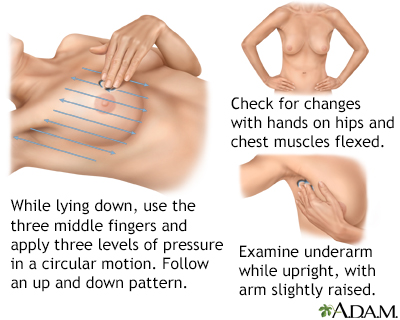Pregnancy SmartSiteTM
Premenstrual tenderness and swelling of the breasts; Breast tenderness - premenstrual; Breast swelling - premenstrual DefinitionPremenstrual swelling and tenderness of both breasts often occurs during the second half of the menstrual cycle. ConsiderationsSymptoms of premenstrual breast tenderness may range from mild to severe. Symptoms usually:
Breast tissue may have a dense, bumpy, "cobblestone" feel to the fingers. This feel is usually more in the outer areas, particularly near the armpit. There may also be an off and on or ongoing sense of breast fullness with dull, heavy pain, and tenderness. CausesHormone changes during the menstrual cycle may lead to breast swelling. More estrogen is made early in the cycle and it peaks just before mid-cycle. This causes the breast ducts to grow in size. The progesterone level peaks near the 21st day (in a 28-day cycle). This causes growth of the breast lobules (milk glands). Premenstrual breast swelling is often linked with:
Premenstrual breast tenderness and swelling probably occur to some degree in nearly all women. More severe symptoms may occur in many women during their childbearing years. Symptoms may be less in women taking birth control pills. Risk factors may include:
Home CareSelf-care tips:
You should practice breast awareness. Do check your breasts for changes at regular intervals. The effectiveness of vitamin E, vitamin B6, and herbal preparations such as evening primrose oil are somewhat controversial. This should be discussed with your health care provider. When to Contact a Medical ProfessionalContact your provider if you:
What to Expect at Your Office VisitYour provider will take your medical history and do a physical examination. The provider will check for breast lumps, and will note the qualities of the lump (firm, soft, smooth, bumpy, and so on). A mammogram or breast ultrasound may be done. These tests will evaluate any abnormal finding on a breast exam. If a lump is found that is not clearly benign, you may need a breast biopsy. These medicines from your provider may reduce or eliminate symptoms:
ReferencesAmerican College of Obstetricians and Gynecologists website. Dysmenorrhea: painful periods. www.acog.org/patient-resources/faqs/gynecologic-problems/dysmenorrhea-painful-periods. Updated January 2022. Accessed April 25, 2024. Cox DM, Lippe C, Geletzke AK, et al. Etiology and management of benign breast disease. In: Klimberg VS, Gradishar WJ, Bland KI, Korourian S, White J, Copeland EM, eds. Bland and Copeland's The Breast: Comprehensive Management of Benign and Malignant Diseases. 6th ed. Philadelphia, PA: Elsevier; 2024:chap 14. Expert Panel on Breast Imaging; Holbrook AI, Moy L, Akin EA, et al. ACR appropriateness criteria breast pain. J Am Coll Radiol. 2018;15(11S):S276-S282. PMID: 30392596 pubmed.ncbi.nlm.nih.gov/30392596/. Mendiratta V, Lentz GM. Primary and secondary dysmenorrhea, premenstrual syndrome, and premenstrual dysphoric disorder: etiology, diagnosis, management. In: Gershenson DM, Lentz GM, Valea FA, Lobo RA, eds. Comprehensive Gynecology. 8th ed. Philadelphia, PA: Elsevier; 2022:chap 35. Sandadi S, Rock DT, Orr JW, Valea FA. Breast diseases: detection, management, and surveillance of breast disease. In: Gershenson DM, Lentz GM, Valea FA, Lobo RA, eds. Comprehensive Gynecology. 8th ed. Philadelphia, PA: Elsevier; 2022:chap 15. | ||
| ||
Review Date: 4/16/2024 Reviewed By: John D. Jacobson, MD, Professor Emeritus, Department of Obstetrics and Gynecology, Loma Linda University School of Medicine, Loma Linda, CA. Also reviewed by David C. Dugdale, MD, Medical Director, Brenda Conaway, Editorial Director, and the A.D.A.M. Editorial team. View References The information provided herein should not be used during any medical emergency or for the diagnosis or treatment of any medical condition. A licensed medical professional should be consulted for diagnosis and treatment of any and all medical conditions. Links to other sites are provided for information only -- they do not constitute endorsements of those other sites. No warranty of any kind, either expressed or implied, is made as to the accuracy, reliability, timeliness, or correctness of any translations made by a third-party service of the information provided herein into any other language. © 1997- A.D.A.M., a business unit of Ebix, Inc. Any duplication or distribution of the information contained herein is strictly prohibited. | ||


 Female Breast
Female Breast Breast self-exam
Breast self-exam Breast self-exam
Breast self-exam
